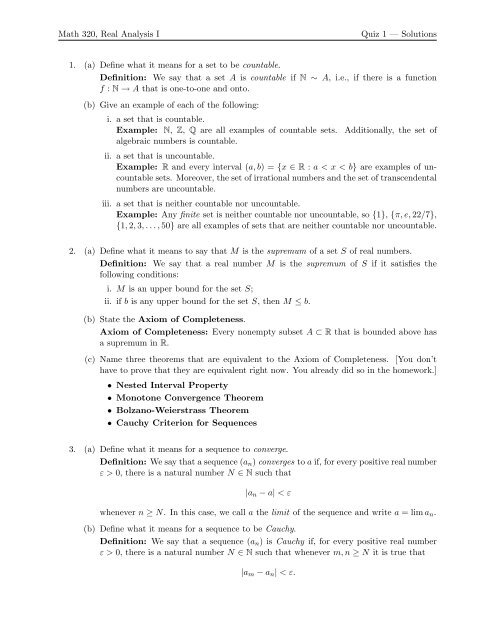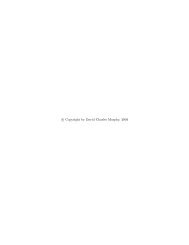Math 320, Real Analysis I Quiz 1 — Solutions 1. (a) Define what it ...
Math 320, Real Analysis I Quiz 1 — Solutions 1. (a) Define what it ...
Math 320, Real Analysis I Quiz 1 — Solutions 1. (a) Define what it ...
Create successful ePaper yourself
Turn your PDF publications into a flip-book with our unique Google optimized e-Paper software.
<strong>Math</strong> <strong>320</strong>, <strong>Real</strong> <strong>Analysis</strong> I<br />
<strong>Quiz</strong> 1 <strong>—</strong> <strong>Solutions</strong><br />
<strong>1.</strong> (a) <strong>Define</strong> <strong>what</strong> <strong>it</strong> means for a set to be countable.<br />
Defin<strong>it</strong>ion: We say that a set A is countable if N ∼ A, i.e., if there is a function<br />
f : N → A that is one-to-one and onto.<br />
(b) Give an example of each of the following:<br />
i. a set that is countable.<br />
Example: N, Z, Q are all examples of countable sets.<br />
algebraic numbers is countable.<br />
Add<strong>it</strong>ionally, the set of<br />
ii. a set that is uncountable.<br />
Example: R and every interval (a, b) = {x ∈ R : a < x < b} are examples of uncountable<br />
sets. Moreover, the set of irrational numbers and the set of transcendental<br />
numbers are uncountable.<br />
iii. a set that is ne<strong>it</strong>her countable nor uncountable.<br />
Example: Any fin<strong>it</strong>e set is ne<strong>it</strong>her countable nor uncountable, so {1}, {π, e, 22/7},<br />
{1, 2, 3, . . . , 50} are all examples of sets that are ne<strong>it</strong>her countable nor uncountable.<br />
2. (a) <strong>Define</strong> <strong>what</strong> <strong>it</strong> means to say that M is the supremum of a set S of real numbers.<br />
Defin<strong>it</strong>ion: We say that a real number M is the supremum of S if <strong>it</strong> satisfies the<br />
following cond<strong>it</strong>ions:<br />
i. M is an upper bound for the set S;<br />
ii. if b is any upper bound for the set S, then M ≤ b.<br />
(b) State the Axiom of Completeness.<br />
Axiom of Completeness: Every nonempty subset A ⊂ R that is bounded above has<br />
a supremum in R.<br />
(c) Name three theorems that are equivalent to the Axiom of Completeness. [You don’t<br />
have to prove that they are equivalent right now. You already did so in the homework.]<br />
• Nested Interval Property<br />
• Monotone Convergence Theorem<br />
• Bolzano-Weierstrass Theorem<br />
• Cauchy Cr<strong>it</strong>erion for Sequences<br />
3. (a) <strong>Define</strong> <strong>what</strong> <strong>it</strong> means for a sequence to converge.<br />
Defin<strong>it</strong>ion: We say that a sequence (a n ) converges to a if, for every pos<strong>it</strong>ive real number<br />
ε > 0, there is a natural number N ∈ N such that<br />
|a n − a| < ε<br />
whenever n ≥ N. In this case, we call a the lim<strong>it</strong> of the sequence and wr<strong>it</strong>e a = lim a n .<br />
(b) <strong>Define</strong> <strong>what</strong> <strong>it</strong> means for a sequence to be Cauchy.<br />
Defin<strong>it</strong>ion: We say that a sequence (a n ) is Cauchy if, for every pos<strong>it</strong>ive real number<br />
ε > 0, there is a natural number N ∈ N such that whenever m, n ≥ N <strong>it</strong> is true that<br />
|a m − a n | < ε.
<strong>Math</strong> <strong>320</strong>, <strong>Real</strong> <strong>Analysis</strong> I<br />
<strong>Quiz</strong> 1 <strong>—</strong> <strong>Solutions</strong><br />
(c) Prove that every convergent sequence is a Cauchy sequence.<br />
Proof. Let (a n ) be a convergent sequence w<strong>it</strong>h lim<strong>it</strong> a = lim a n . Let ε > 0 be arb<strong>it</strong>rary.<br />
Then ε/2 > 0 as well, so there is a natural number N ∈ N such that<br />
|a n − a| < ε 2<br />
whenever n ≥ N. Now suppose m, n ∈ N w<strong>it</strong>h m, n ≥ N and consider<br />
|a m − a n | = |a m − a + a − a n | = |(a m − a) + (a − a n )| ≤ |a m − a| + |a − a n | < ε 2 + ε 2 = ε<br />
by the Triangle Inequal<strong>it</strong>y. Therefore, |a m −a n | < ε whenever m, n ≥ N, so the sequence<br />
(a n ) is Cauchy.<br />
4. (a) <strong>Define</strong> <strong>what</strong> <strong>it</strong> means for an infin<strong>it</strong>e series to converge.<br />
Defin<strong>it</strong>ion: We say that the infin<strong>it</strong>e series ∑ b n converges to B if <strong>it</strong>s sequence of partial<br />
sums (s m ), whose m-th term is given by s m = b 1 + b 2 + b 3 + · · · + b m for all m ∈ N,<br />
converges to B.<br />
(b) Give an example of each of the following, or state that such a request is impossible by<br />
referring to the proper theorem(s):<br />
i. a convergent infin<strong>it</strong>e series that is commutative.<br />
Example: By the Rearrangement Theorem, every series that is absolutely convergent<br />
is commutative. So the series<br />
∞∑ 1<br />
n 2 = 1 + 1 4 + 1 9 + 1 16 + · · · ,<br />
n=1<br />
which converges since <strong>it</strong> is a p-Series w<strong>it</strong>h p = 2 > 1 and is absolutely convergent<br />
since ∑ ∣ ∣ ∣∣<br />
1 ∣∣∣<br />
n 2 = ∑ 1 again which converges, is an example of a convergent infin<strong>it</strong>e<br />
n2 series that is commutative.<br />
ii. a convergent infin<strong>it</strong>e series whose sequence of partial sums is unbounded.<br />
Impossible! If ∑ b n is a convergent infin<strong>it</strong>e series, then <strong>it</strong>s sequence of partial sums,<br />
(s m ), must converge by the defin<strong>it</strong>ion of convergence of an infin<strong>it</strong>e series. Yet, if (s m )<br />
converges, then (s m ) is bounded, for every convergent sequence is bounded. Thus<br />
<strong>it</strong> is impossible to find an example of a convergent infin<strong>it</strong>e series whose sequence of<br />
partial sums is unbounded.<br />
iii. a convergent infin<strong>it</strong>e series that is not absolutely convergent.<br />
Example: The Alternating Harmonic Series,<br />
∞∑ (−1) n+1<br />
= 1 − 1 n 2 + 1 3 − 1 4 + · · · ,<br />
n=1<br />
is a convergent infin<strong>it</strong>e series by the Alternating Series Test, but <strong>it</strong> is not absolutely<br />
convergent since the associated series of absolute values, ∑ ∞<br />
n=1 ∣ (−1)n+1<br />
n<br />
∣ =<br />
∑ ∞<br />
n=1 1 n = 1 + 1 2 + 1 3 + 1 4<br />
+ · · · , is the Harmonic Series, which diverges.<br />
iv. an absolutely convergent infin<strong>it</strong>e series that is not convergent.<br />
Impossible! By the Absolute Convergence Test, every absolutely convergent<br />
series is convergent.
















